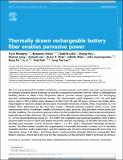Thermally drawn rechargeable battery fiber enables pervasive power
Author(s)
Khudiyev, Tural; Grena, Benjamin; Loke, Gabriel; Hou, Chong; Jang, Hyeonji; Lee, Jinhyuk; Noel, Grace H; Alain, Juliette; Joannopoulos, John; Xu, Kang; Li, Ju; Fink, Yoel; Lee, Jung Tae; ... Show more Show less
DownloadAccepted version (2.361Mb)
Publisher with Creative Commons License
Publisher with Creative Commons License
Creative Commons Attribution
Terms of use
Metadata
Show full item recordAbstract
The increasing demand for mobile computing, communications, and robotics presents a growing need for suitable portable power solutions in non-flat customized electronic devices. Fibers as fundamental building blocks of fabrics and 3D-printed objects provide unique opportunities for developing pervasive multidimensional power systems. The characteristic small diameter (<10−3 m) and high aspect ratios (>106) of fibers and expansion of fibers into 2D and 3D power systems necessitate ultra-long lengths to meet the energy specifications of portable electronic systems. Here, we present a Li-ion battery fiber, fabricated for the first time using a thermal drawing method which occurs with simultaneous flows of multiple complex electroactive gels, particles, and polymers within protective flexible cladding. This top-down approach allows for the production of fully-functional and arbitrarily long lithium-ion fiber batteries. The continuous 140 m fiber battery demonstrates a discharge capacity of ∼123 mAh and discharge energy of ∼217 mWh. The scalability and material tunability of these fibers position them for use in varied non-planar electronic systems, including a 1D-flexible electronic fiber, a 2D-large-scale machine woven electronic fabric (∼1.6 m2), and a 3D-printed structural electronic system. The fiber battery satisfies the requirements of portable electronics systems as it is machine washable, flexible, usable underwater, and fire/rupture-safe. We have demonstrated the powering of a submarine drone, LiFi fabric, and flying drone communication through different rechargeable fiber battery schemes, which paves the way for the emergence of the pervasive battery-powered electronics.
Date issued
2021Department
Massachusetts Institute of Technology. Research Laboratory of Electronics; Massachusetts Institute of Technology. Department of Materials Science and Engineering; Massachusetts Institute of Technology. Department of Nuclear Science and Engineering; Massachusetts Institute of Technology. Department of Chemical Engineering; Massachusetts Institute of Technology. Department of Physics; Massachusetts Institute of Technology. Institute for Soldier NanotechnologiesJournal
Materials Today
Publisher
Elsevier BV
Citation
Khudiyev, Tural, Grena, Benjamin, Loke, Gabriel, Hou, Chong, Jang, Hyeonji et al. 2021. "Thermally drawn rechargeable battery fiber enables pervasive power." Materials Today, 52.
Version: Author's final manuscript